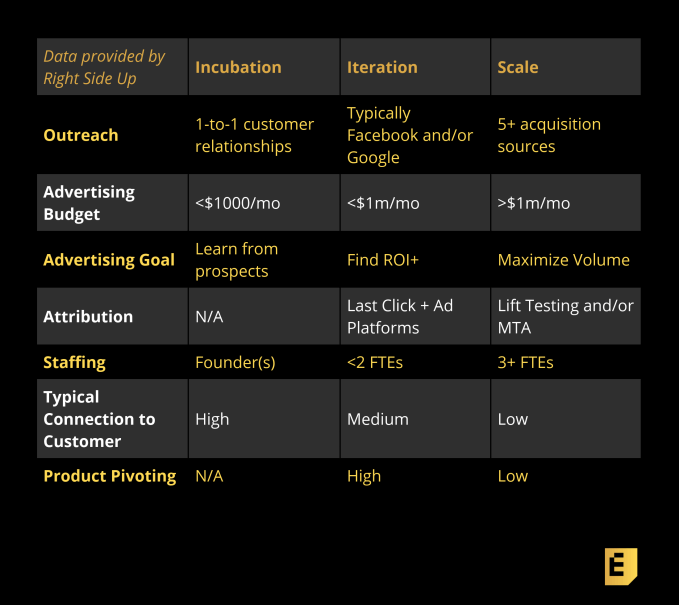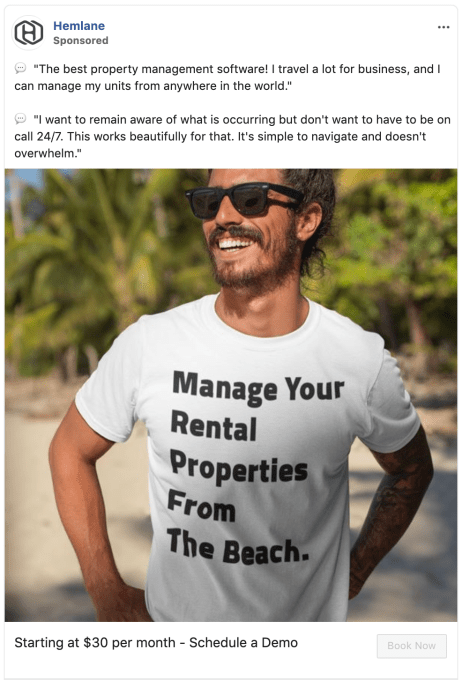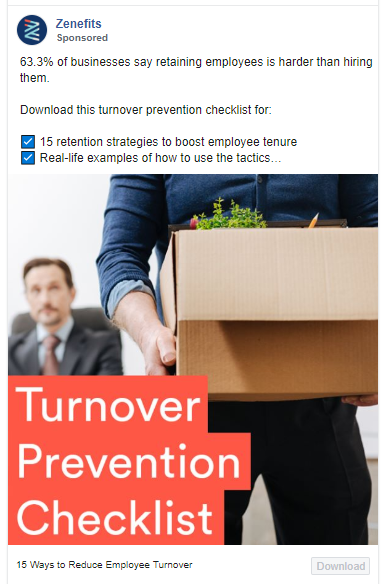Tyler Elliston
Over the years, we’ve seen a lot of B2B companies apply ineffective demand generation strategies to their startup. If you’re a B2B founder trying to grow your business, this guide is for you.
Rule #1: B2B is not B2C. We are often dealing with considered purchases, multiple stakeholders, long decision cycles, and massive LTVs. These unique attributes matter when developing a growth strategy. We’ll share B2B best practices we’ve employed while working with awesome B2B companies like Zenefits, Crunchbase, Segment, OnDeck, Yelp, Kabbage, Farmers Business Network, and many more. Topics covered include:
- Descriptions of growth stages you can use to determine your company’s status
- Tactics for each stage with specific examples
- Which advertising channels work best
- Optimization of your ad copy to maximize CTR and conversions
- Optimization of your sales funnel
- Measuring the ROI of your advertising spend
We often crack growth for companies that didn’t think it was possible, based on their prior experience with agencies and/or internal resources. There are many misconceptions out there about B2B growth, rooted in the misapplication of B2C strategies and leading to poor performance. Study the differences and you’ll develop a filter for all the advice you get that’s good for one context (ex: B2C) but bad for another (ex: B2B). This guide will get you off on the right foot.
Table of Contents
- What growth stage is your B2B startup?
- How do you find B2B customers?
- When do you use which channels?
- What kind of marketing messaging should you use?
- How do you build your sales funnel?
- How should you calculate and use the ROI of your marketing budget?
- In summary
What growth stage is your B2B startup?
The best growth strategy for your company ultimately depends on whether you’re in an incubation, iteration, or scale stage. One of the most common mistakes we see is a company acting like they’re in the scale phase when they’re actually in the iteration phase. As a result, many of them end up developing inefficient growth strategies that lead to exorbitant monthly ad spends, extraneous acquisition channels, hiring (and later firing) ineffective team members, and de-emphasizing critical customer feedback. There is often an intense pressure to grow, but believing your own hype before it’s real can kill early-stage ventures. Here’s a breakdown of each stage:

Incubation is when you are building your minimum viable product (MVP). This should be done in close partnership with potential customers to ensure you are solving a real problem with a credible solution. Typically a founder is a voice of the customer, as someone who experienced the problem and sought out the solution s/he is now building. Other times, founders enter a new space and build a panel of prospective buyers to participate in the product development process. The endpoint of this phase is a working MVP.
Iteration is when you have customers using your MVP and you are rapidly improving the product. Success at this stage is rooted in customer insights – both qualitative and quantitative – not marketing excellence. It’s valuable to include in this iterative process customers with whom the founder(s) have no prior relationship. You want to test the product’s appeal, not friends’ willingness to help you out. We want a customer set that is an accurate sample of a much larger population you will later sell to. The endpoint of the iteration phase is product/market fit.
Scale is when you have product/market fit and are trying to grow your customer base. The goal of this phase is to build a portfolio of tactics that maximize market penetration with minimal – or at least profitable – cost. Success is rooted in growing lifetime value through retention and margin, maximizing funnel conversion to efficiently convert leads to customers, and finding repeatable tactics to drive prospective buyers’ awareness and consideration of your product. The endpoint of this phase is ultimately market saturation, leading to the incubation and iteration of new features, customer segments, and geographies.
How do you find B2B customers?
Here’s a list of B2B customer acquisition tactics we commonly employ and recommend. Later in this article, we’ll connect each channel to the growth stage it’s best used in. This list is generally sorted by early stage to later stage:
1. Leverage your network. This is particularly valuable for founders who are building a product based on their own past experience.
- Reach out to old colleagues you know have the same problem you had (and are solving).
- Leverage the startup ecosystem. If your startup is in YCombinator, for instance, other companies in your batch may be prospects, along with alumni who will take your call simply because of your affiliation.
- Example: If you’re building an app for marketers, ask past marketing colleagues you’ve worked with to try out your product is a no brainer.
2. Cold calling (or showing up in person). Knock on doors, make phone calls. You have to get used to hearing “no”, but you’d be surprised how often you can get people to try your product once you have a personal connection.
- Your first step is creating a list of potential prospects with phone numbers. This works best in industries where phone numbers are easily available, like when your target is small business owners. It works less well for trying to make sales to big companies.
- Example: Years ago, I worked for an eco-fashion wholesaler and wanted retailers to attend a conference I had set-up to pitch them on our product. I made a list of hundreds of clothing boutiques in Manhattan, sorted them into clusters, and personally walked to each one to invite the owners to the event. It worked very well – the event was packed with target customers.
- Example #2: I worked at OnDeck, an innovative business loan provider. Most of our early customers were acquired by calling small business owners to let them know about a new type of business funding. Cold calling is both a good tool early on and a good tool for scaling later, because you can hire more salespeople to follow a script you perfect.
- Cold email/LinkedIn outreach. It’s easy to get lists of prospects these days from companies like Clearbit. The response rate will be low, but you can reach target customers from most verticals this way. It’s important to make the email about their needs, not yours. How can your product help them? Why should they do a demo? You’ll have to send out many, many emails to get good responses. It may be worth upgrading to a premium LinkedIn account to be able to send InMails. On the email side, tools like Reply.IO or Outreach.IO make life much easier because they automate your email responses.
- Example: We’ve helped execute successful cold email campaigns that generated significant revenue by targeting HR managers, corporate venture teams, fashion retailers, accountants and more. We found lists of their target customers who could be interested in the products, put the potential customers into email flows, and followed up manually with people who replied to the automated emails to get sales.
3. Events. For almost any industry, there are events and trade shows where you can find customers.
- Start by visiting local meet-ups near you related to your industry, and talking to attendees and speakers to learn more about industry needs. Pitch your product when it makes sense in polite conversation.
- Take this to the next level by attending industry conferences. Go as an attendee at first to confirm that the people there are actually your target customer. When you have something to pitch and are willing to spend a little bit of money, try being an exhibitor. Don’t underinvest in your booth presence and assets, as this undermines your credibility significantly. Do everything you can to capture attendee information, both through a directory and at-the-booth gimmicks (ex: giveaways). This information – attendees’ names, phone numbers, and email addresses – can be used to create custom audiences and lookalike audiences in digital advertising.
- Once conference organizers know you, you’ll be more likely to get speaking slots if you have something compelling to say – it helps if you start with small events.
- Example: For the eco-fashion event referenced earlier, I got most of my star speakers by meeting them at other people’s events and making a connection.
4. Paid digital. Facebook and Google make up 90%+ of all new online ad spend – these two channels are generally the best place to start testing online advertising. If neither Facebook or Google work for you, double-check your product/market fit. A big advantage of paid digital is that you get results immediately, so you can optimize ad spend and learn what works while spending less money and time compared to other channels.
- Facebook is for attention-based marketing – if your customers don’t know your product category exists, you have to show up in front of them on Facebook and show them how your product can help them. We’ve written a very detailed guide on how B2B startups can use Facebook ads.
- Google is for intent-based marketing – if your customers know your product category exists, you want to show up when they search for your product online.
- You should almost always start with Google and eventually port your results to Bing. It is a much more efficient use of your time than trying to do both at once.
- LinkedIn has great targeting capabilities for B2B but it’s very expensive. Very few companies achieve positive ROI and even fewer are able to scale it beyond $25,000/mo.
- There is no other attention-based marketing channel besides Facebook that can target B2B customers at scale. Display networks, LinkedIn, Twitter, etc. are not a great use of time for a startup since the scale is low and good ROI is rare.
- Examples: Our agency specializes in growing B2B companies through paid ads on Facebook and Google, and we’ve successfully grown revenue for:
- Zenefits – HR Professionals at companies of all sizes
- Brightwheel – Preschool and daycare owners
- Hemlane – Rental property managers
- OnDeck – Creditworthy small business owners
- Roger.AI – Accountants
5. Paid physical. Direct mail and postcards may be old school, but they can work for B2B at massive scale. Everyone has an address. It’s more expensive to get in front of each person, but you can choose exactly who gets your mail so you only show up in front of people who qualify for and want your product.
- Example: When I worked for OnDeck, we used direct mail extensively to acquire customers. We built lists of small business owners throughout America using tools like Infogroup, sorted them by industry and company size, and mailed the ones that seemed like the best fit for our type of financing.
- The key to direct mail is to try to not look too promotional. A simple typed letter (with good copywriting) usually works better than something flashy for B2B. People will throw away your letter without opening it if it looks like spam.
6. Content Marketing and SEO. Content marketing means writing articles and creating content to get in front of people searching for information about your product category. Content marketing has a big upfront investment, and it takes a long time to get results. That said, if it works, it is cheaper in the long term than constantly paying for Google ads.
- The stuff that’s worked best is long, useful content related to search terms that people often search for. Lookup a few keywords and see what the pages look like for the companies on the front page.
- You can use Google Keyword Planner to figure out which keywords have volume worth building articles around. Type in some keywords related to your industry and see what Google tells you about how many people search for those and related keywords monthly.
When do you use which channels?

For Incubation…
In the incubation stage, you’ll be doing a lot of manual outreach to get your first paying customers, and improving the product based on feedback. The channels above most often used in this stage are leveraging your network, cold calling, cold email/LinkedIn outreach, and going to events.
You don’t need much marketing budget in the innovation period, assuming you’re using your own labor for all this outreach. $500 per month to afford tools like Clearbit (to get lists), Reply.IO (To help with cold email) and LinkedIn Pro (To send messages on LinkedIn) should be fine.
For additional reading on the topic, we recommend Paul Graham’s essay Do Things That Don’t Scale.
For Iteration…
The iteration stage, like the incubation stage, includes manual outreach. The big difference is you want to get more strangers outside of your network and social circles to try your product.
This means expanded focus on cold calling, email and outreach. It also means you can start paid digital ads on Facebook and Google. This will help you learn more about what messaging brings in potential customers. For instance, you can find out things like which of your product’s features customers like more by putting different features in different ads and seeing which ad gets higher click through rates.
At this stage, in addition to your efforts on cold calling and emailing prospects, you’ll probably want to budget about $2,500 in testing efforts on Facebook and/or Google to see if you can really get people you don’t know personally to pay for your product.
For Scaling…
So you have a couple hundred paying customers, they like your product, and your customer churn is low. How do you scale the business from there?
Paid digital, paid physical and content/SEO are the three channels that offer the greatest scale for B2B companies. If you build a strong sales team, cold email and cold calling can both scale, but this involves building out a serious sales organization.
The easiest channel to start testing is paid digital, because it has the fastest time to get results and smallest investment needed. You still need a minimum of $5k test spend in paid digital, and in reality closer to $20k, to get a good idea of long term cost per conversion.
If, however, you’ve spent your first $5,000 on advertising and have only seen a handful of conversions, you should probably stop there and re-evaluate either your product-market fit or your marketing strategy. Even for B2B, where deal size is bigger and leads can be pricier, your cost per lead should very rarely be over $500 (and will usually end up being much lower).
What kind of marketing messaging should you use?
Generally, if you’re targeting companies with 10 or less employees, use ad messaging that directly promotes your product. Since there’s usually only one decision-maker/stakeholder, these companies will convert into customers directly from ads.
Here’s an example ad for a property management software:

If you’re targeting companies with 10-10,000+ employees, use marketing messaging that promote resources closely related to your project. Resources are eBooks, guides, tools, and things that are useful to customers that are related to the product you’re selling, but are not actually your product.
There are usually multiple stakeholders for any given business decision at bigger companies, so resource downloads allow you to start the sales process with target companies without needing an upfront commitment from them to try out your product.
Resources like those mentioned above let you do a few things:
- If you request contact information in exchange for the resource (which you should!), you now have the contact information of a person at a company that could want your product.
- The target customer now also has a reference to your company which was both helpful and will remind them that you exist.
- The person who downloaded the eBook will often share it with their teammates, so multiple stakeholders could start to discuss your company as a solution to their problems.
- You or your sales team can then try to reach out to them to upsell that target into trying your product.
For instance, Zenefits sells HR software. The goal of the ad below is to get leads interested in a tool for HR people who can later be upsold into paying customers:

For any kind of ad you build, we recommend using the SUCCESS Framework to make sure the messaging is effective.
The SUCCESS Framework is the core idea of a great marketing book called Made to Stick by Chip Heath and Dan Heath, and it’s based on peer-reviewed research. It says that marketing that considers the following aspects do better than ads made without following the rubric. Basically, take 2–3 of the attributes below and try to make your marketing messaging with it:
- Simple
- Unexpected
- Credible
- Concrete
- Emotional
- Stories
How do you build your sales funnel?
Almost all B2B businesses require the use of a sales team to successfully convert potential customers into paying customers. This is important for B2B companies at every stage.
Every startup owner knows that making your website better will increase conversion rate. This is why there are books devoted to A/B testing and Conversion Rate Optimization. You wouldn’t send your customers to a 90s style Geocities site with a blinking marquis banner and under construction signs.
Not optimizing your sales funnel and team in B2B is like sending people to a 90s site.
Keys to building a good sales funnel include:
1. Create an automated sales nurture flow that comes from a sales account (reply.io or outreach.io are great tools). This is most commonly done with email, but can also be done with app notifications and SMS.
- What is a nurture flow? When someone submits their information to you as a lead, the nurture flow is organization of how you send them messages and get in touch. An example nurture flow would be 1) Lead comes in 2) They get their first email within a minute 3) They get their 2nd email three days later 4) They get a phone call five days later, etc.
2. Create a marketing nurture funnel – usually with email – for people who fall out of the sales funnel after a month.
- A marketing nurture funnel is like the sales funnel described below, but is usually less “salesy”. A good example would be subscribing someone to a useful monthly newsletter.
3. Create a task-based system to organize sales calls.
- Yes, people still pick up and convert from phone calls.
- The faster you call people after they submit their lead information, the more likely they will convert. Response time is a good variable to test. See how conversion rates differ when you respond within 5 minutes vs. 24 hours.
- You need a system to make sure your salespeople call enough leads.
How should you calculate and use the ROI of your marketing budget?
ROI calculation seems simple, right? Subtract what you paid for marketing and sales from your revenue per sale, and you can see how effective your spend is. A few things complicate this:
- Lifetime value – How can you tell how valuable a sale is on a monthly subscription product? Most people do this by calculating out monthly churn (how many customers leave every month) and using that to determine how long customers will keep paying for your product. How much of lifetime value you should spend on customer acquisition is very nuanced depending on your confidence in your modeling, cash position, plans to raise additional funds, and plans to increase features/monetization. Most companies require a 12-24 month payback on their advertising spend.
- Cost of your sales team – Don’t forget to account for what it costs to employ salespeople in your ROI. If you’re selling as a founder, try to account for the time you spend on the phone each week. Some B2B products require extensive human engagement. In such cases, marketing will need lower CAC thresholds.
- Vintage periods – How long does it take the average customer to close after they become a lead? For many B2B products, the answer is anywhere from 7 days to 7 months. To calculate the return on your ad spend, you have to track what results came from a given month’s spend, no matter when those sales close down the line. If a lead closes in August but originated from May spend, it should be attributed to May’s marketing performance.
In summary
These are the basics of how B2B startups should think about growth:
- Figure out the growth stage your company is in.
- Figure out which growth channels fit that growth stage, and execute on them.
- Expand to new growth channels as your company matures and you’re more sure of your product/market fit.
- Improve your messaging, sales team, and tracking over time.
- Double down on the channels that work best for you.
It’s a process of continually testing channels and targeting, optimizing performance, improving your funnel, and repeating until your ROI and scale are where you want them to be.































Comment